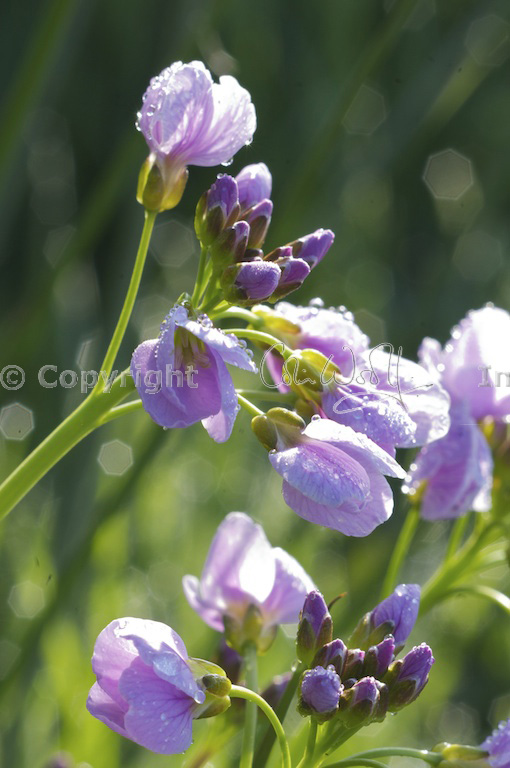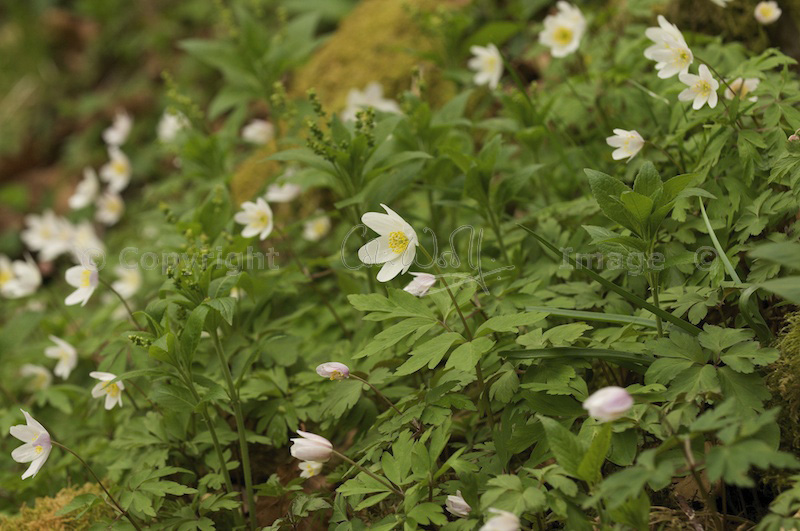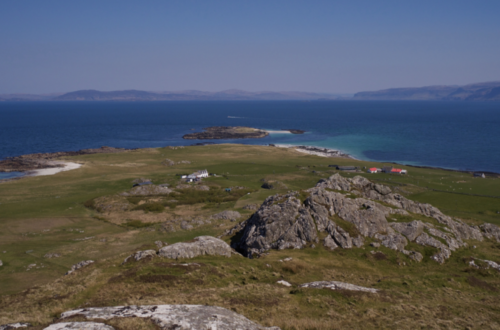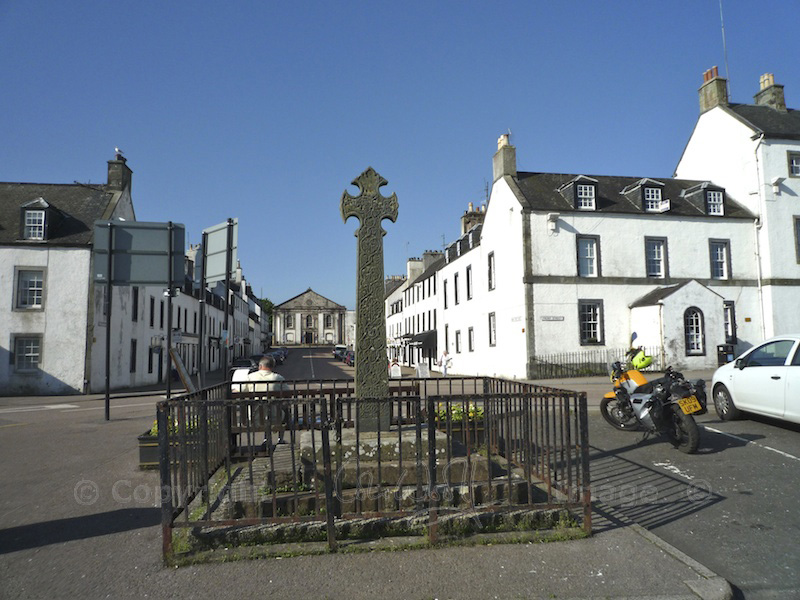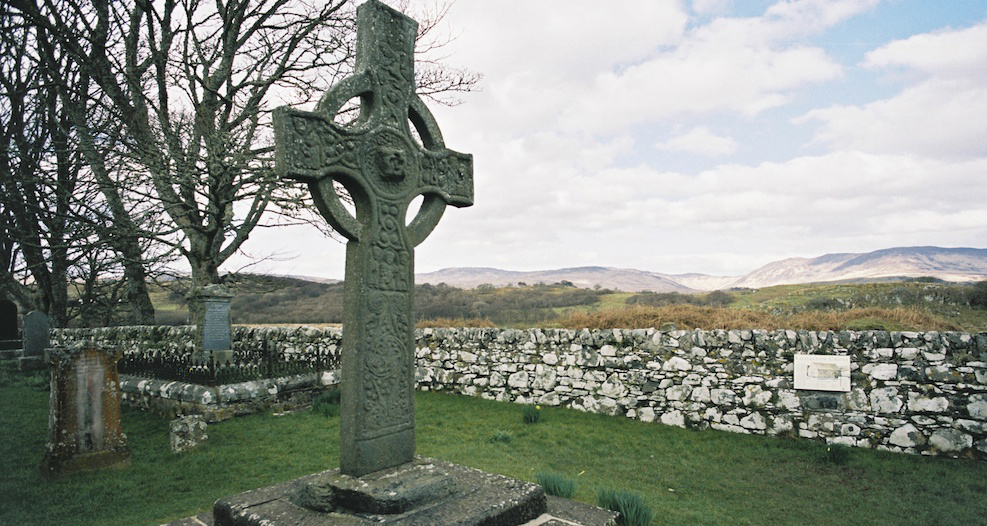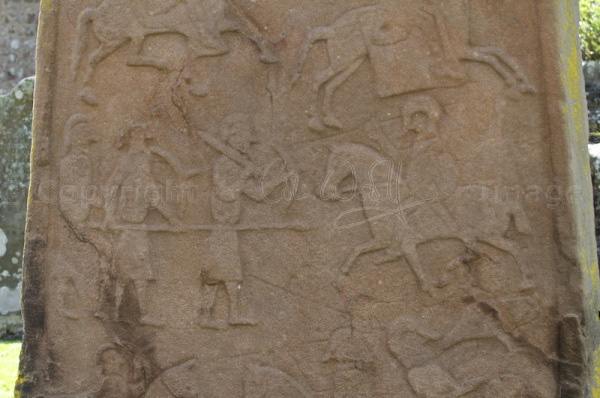
The Battle of Dunnichen
 When I was browsing through my photos of the Aberlemno sculptured stones yesterday, I started to look again at one of the carvings, and an article almost started to write itself.
When I was browsing through my photos of the Aberlemno sculptured stones yesterday, I started to look again at one of the carvings, and an article almost started to write itself.
I didn’t realise at the time that today is the anniversary of the battle that the stone is believed to depict.
On 20th May 685 – we know the precise date, thanks to the Venerable Bede, a Northumbrian monk – the massed forces of the Angles under their king, Ecgfrith, and the Picts, led by King Bridei, came to blows over the ownership of territory that the Angles had coveted ever since setting foot on our shores. The battle was both bloody and decisive, and resulted in victory for the Picts: the Angles were driven back southwards, and Ecgfrith perished on the battlefield.
The event is known as the Battle of Dunnichen or Dun Nechtain. The trouble is, we’re not entirely sure where it took place. Some accounts place it at Dunnichen in Angus, while others point to Dunachton on the shore of Loch Insh, near Aviemore. It doesn’t help that the battle site has also been called Nechtansmere.
In the quiet village of Aberlemno in Angus are four beautifully sculptured stones: three are ranged along the roadside and a fourth stands in the churchyard. It’s the fourth stone that we’re going to have a look at, and it’s impossible to miss, towering high above all the other more recent grave slabs and tombstones. An elaborate Celtic cross is carved on the front, but if you walk around to the other side you’re presented with a battle scene as dramatic now as it was 1300 years ago.
In his book ‘A History of Scotland’, Neil Oliver compares the carving on this stone to the Bayeux tapestry, because it conveys the action in much the same way – like a graphic novel or comic strip. I guess this was the Pictish version of The Dandy or The Beano, although there must have been quite a time lag between issues. And after all, the Picts were named for their love of pictures – or so the Romans would have us believe.
 Anyway, back to the carving: a number of bare-headed and long-haired Pictish spearmen are confronting the Angles, who are recognisable by their helmets. (I am relying on Neil Oliver’s interpretation here, because to my eye all the protagonists look quite similar). Five figures are on horseback, while four are on foot. Oliver says: “The massed and disciplined ranks of Pictish spearmen drove their enemy into the cold, dark waters of a loch and butchered them there.”
Anyway, back to the carving: a number of bare-headed and long-haired Pictish spearmen are confronting the Angles, who are recognisable by their helmets. (I am relying on Neil Oliver’s interpretation here, because to my eye all the protagonists look quite similar). Five figures are on horseback, while four are on foot. Oliver says: “The massed and disciplined ranks of Pictish spearmen drove their enemy into the cold, dark waters of a loch and butchered them there.”
In the lower right-hand corner, a bird is shown pecking at a body, assumed to be a dead or dying Anglo warrior. We are meant to be in no doubt of the outcome – this stone was designed to convey the triumph and power of the Picts to many future generations. As Neil Oliver observes, “Bridei had done much more than win a battle – by the power of his own will he had forced the Picts to unite under the leadership of one king.”
But what about the intriguing symbols above the battle scene – what are they all about? A square with scrolls inside it and a notch cut out of the lower side, with a decorative zig-zag line superimposed on it; and three discs laid vertically, the central one much larger than the other two. (Ignore the hole that pierces the slab – that was made much later). These shapes can be seen on many other Pictish stones scattered throughout Scotland, but the truth is that we have no idea what they represent.
Iain Forbes, author of ‘The Last of the Druids’, believes that the symbols may refer to an astronomical alignment at the time of the battle. Having studied star charts for the relevant date, he speculates that the diagonal line over the notched square may refer to the presence of Mercury and Jupiter within the constellation of Gemini. The triple disc symbol may represent the constellation of Auriga, the charioteer: on 20th May 685, the sun was immediately below Capella, the brightest star in Auriga, and would have remained there for several days.
Alternatively, Forbes suggests that the disc symbol could refer to the position of Saturn in relation to the constellation of Crater. Crater is also known as ‘Apollo’s Cup’ and to the Picts it may have resembled a cauldron. Forbes explains: “Looking at the battle date, we find the planet Saturn was directly above this constellation.”
This theory relies a great deal on the assumption that the Picts could read and understand the heavens, and knew where stars and planets were, even when they were absent from the night sky. It also assumes that they understood astrology, and could make prophecies based on the position of celestial bodies. That is not at all unlikely. I strongly believe that we have lost most of this instinctive kind of knowledge in the process of ‘evolution’.
What we don’t know, of course, is whether the druids or astrologers predicted the glorious victory – they may even have selected the date and location as being particularly auspicious – or whether they just glanced at their star charts afterwards and nodded their heads sagely, saying ‘It was as I thought’ (or something similar in Pictish).
 The beautiful Celtic cross that is carved on the other side of the slab is a sign that the Picts were gradually absorbing the religion of Christianity, which had arrived in the shape of missionaries such as St Columba and St Brendan from Ireland, and St Ninian, possibly a Briton who was known as the ‘Apostle to the Southern Picts’. As for combining symbols from Christianity with their earlier, pagan beliefs, the Picts thought nothing of it. Perhaps they reckoned that, if one god didn’t listen to them, the others would.
The beautiful Celtic cross that is carved on the other side of the slab is a sign that the Picts were gradually absorbing the religion of Christianity, which had arrived in the shape of missionaries such as St Columba and St Brendan from Ireland, and St Ninian, possibly a Briton who was known as the ‘Apostle to the Southern Picts’. As for combining symbols from Christianity with their earlier, pagan beliefs, the Picts thought nothing of it. Perhaps they reckoned that, if one god didn’t listen to them, the others would.
The Picts might have left us guessing about quite a bit in terms of their language and culture, but here at least is something we can easily appreciate and understand. You wonder if they held celebrations at the stone to mark every anniversary of the battle, and you also wonder where on earth the dead were buried. Some marshy field or windswept glen, somewhere in the Highlands, is hanging on to its secrets.
Sources:
- ‘A History of Scotland’ by Neil Oliver
- ‘The Last of the Druids’ by Iain W G Forbes
- Historic Scotland
- Pictish Stones
- The Last of the Druids
You can also read more in my earlier feature, Aberlemno: Riddles in Stone.
The Aberlemno stones are in the care of Historic Scotland. All are readily visible and free to access. To protect them from the weather, wooden boxes are placed over them from the end of September until the beginning of April.
All photographs copyright © Colin & Jo Woolf
If you’d like to know more about all four of the stones at Aberlemno, take a look at my earlier feature, Aberlemno: Riddles in Stone.
